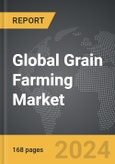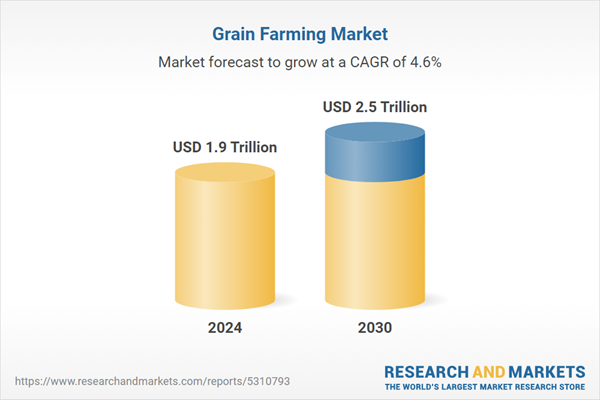The global market for Grain Farming was valued at US$1.9 Trillion in 2024 and is projected to reach US$2.5 Trillion by 2030, growing at a CAGR of 4.6% from 2024 to 2030. This comprehensive report provides an in-depth analysis of market trends, drivers, and forecasts, helping you make informed business decisions. The report includes the most recent global tariff developments and how they impact the Grain Farming market.
Segments: Crop Type (Dry Pea & Bean Farming, Corn Farming, Rice Farming, Wheat Farming, Other Crop Types).
Geographic Regions/Countries: World; United States; Canada; Japan; China; Europe (France; Germany; Italy; United Kingdom; Spain; Russia; and Rest of Europe); Asia-Pacific (Australia; India; South Korea; and Rest of Asia-Pacific); Latin America (Argentina; Brazil; Mexico; and Rest of Latin America); Middle East (Iran; Israel; Saudi Arabia; United Arab Emirates; and Rest of Middle East); and Africa.
The analysts continuously track trade developments worldwide, drawing insights from leading global economists and over 200 industry and policy institutions, including think tanks, trade organizations, and national economic advisory bodies. This intelligence is integrated into forecasting models to provide timely, data-driven analysis of emerging risks and opportunities.
Global Grain Farming Market - Key Trends & Drivers Summarized
How Is Technological Advancement Shaping The Grain Farming Industry?
The grain farming industry is undergoing significant transformation, driven by technological advancements in farming practices, machinery, and crop management. The adoption of precision farming techniques, such as GPS-guided machinery, remote sensing, and data analytics, is enabling farmers to optimize planting, irrigation, fertilization, and pest control, resulting in higher yields and reduced input costs. The use of drones and satellite imagery for crop monitoring is also providing real-time insights into crop health and soil conditions, allowing for timely interventions and better decision-making. Additionally, advancements in genetically modified (GM) crops and hybrid seeds are enhancing crop resilience to diseases, pests, and climate stress, supporting sustainable grain production. These technological innovations are crucial in meeting the growing global demand for grains, driven by population growth and changing dietary habits.What Are The Key Challenges And Opportunities In The Grain Farming Market?
The grain farming market faces several challenges, including climate change, water scarcity, soil degradation, and market volatility. Extreme weather events, such as droughts, floods, and heatwaves, are increasingly impacting grain yields and quality, posing a significant risk to farmers and the food supply chain. However, these challenges also present opportunities for innovation and growth in the grain farming market. The development of climate-resilient crops, sustainable farming practices, and efficient water management systems is creating new opportunities for farmers to enhance productivity and sustainability. Additionally, the rising demand for organic and non-GMO grains is encouraging diversification and the adoption of sustainable agricultural practices, opening new markets and revenue streams for grain producers.How Are Market Dynamics And Trade Policies Influencing The Grain Farming Industry?
Market dynamics, such as the growing global demand for food, feed, and biofuels, and the increasing focus on food security, are significantly influencing the grain farming industry. Trade policies and tariffs, particularly in major grain-producing and exporting countries like the United States, Brazil, Russia, and Australia, are impacting the global grain supply chain and market prices. The ongoing geopolitical tensions and trade disputes are also affecting grain exports and imports, creating uncertainty in the market. Additionally, government subsidies, support programs, and policies aimed at promoting sustainable agriculture and food security are shaping the grain farming landscape, influencing production decisions and market dynamics.What Factors Are Driving The Growth Of The Grain Farming Market?
The growth in the grain farming market is driven by several factors, including technological advancements in farming practices, the rising global demand for food and feed, and supportive government policies. A key driver is the increasing need for efficient and sustainable grain production to meet the growing food demand of a rising global population. The adoption of precision agriculture and smart farming technologies is also enhancing productivity, reducing costs, and improving resource use efficiency. Additionally, the expansion of the biofuels industry and the demand for high-quality grains for animal feed are contributing to market growth. These factors, coupled with the ongoing innovation in crop management and sustainable farming practices, are driving the global grain farming market forward.Report Scope
The report analyzes the Grain Farming market, presented in terms of units. The analysis covers the key segments and geographic regions outlined below.Segments: Crop Type (Dry Pea & Bean Farming, Corn Farming, Rice Farming, Wheat Farming, Other Crop Types).
Geographic Regions/Countries: World; United States; Canada; Japan; China; Europe (France; Germany; Italy; United Kingdom; Spain; Russia; and Rest of Europe); Asia-Pacific (Australia; India; South Korea; and Rest of Asia-Pacific); Latin America (Argentina; Brazil; Mexico; and Rest of Latin America); Middle East (Iran; Israel; Saudi Arabia; United Arab Emirates; and Rest of Middle East); and Africa.
Key Insights:
- Market Growth: Understand the significant growth trajectory of the Dry Pea & Bean Farming segment, which is expected to reach US$671.1 Billion by 2030 with a CAGR of a 4.2%. The Corn Farming segment is also set to grow at 5.3% CAGR over the analysis period.
- Regional Analysis: Gain insights into the U.S. market, valued at $514.2 Billion in 2024, and China, forecasted to grow at an impressive 7.2% CAGR to reach $531.6 Billion by 2030. Discover growth trends in other key regions, including Japan, Canada, Germany, and the Asia-Pacific.
Why You Should Buy This Report:
- Detailed Market Analysis: Access a thorough analysis of the Global Grain Farming Market, covering all major geographic regions and market segments.
- Competitive Insights: Get an overview of the competitive landscape, including the market presence of major players across different geographies.
- Future Trends and Drivers: Understand the key trends and drivers shaping the future of the Global Grain Farming Market.
- Actionable Insights: Benefit from actionable insights that can help you identify new revenue opportunities and make strategic business decisions.
Key Questions Answered:
- How is the Global Grain Farming Market expected to evolve by 2030?
- What are the main drivers and restraints affecting the market?
- Which market segments will grow the most over the forecast period?
- How will market shares for different regions and segments change by 2030?
- Who are the leading players in the market, and what are their prospects?
Report Features:
- Comprehensive Market Data: Independent analysis of annual sales and market forecasts in US$ Million from 2024 to 2030.
- In-Depth Regional Analysis: Detailed insights into key markets, including the U.S., China, Japan, Canada, Europe, Asia-Pacific, Latin America, Middle East, and Africa.
- Company Profiles: Coverage of players such as ADM (Archer Daniels Midland), Bunge Limited, Cargill, Inc., Wilmar International Ltd, BASF SE and more.
- Complimentary Updates: Receive free report updates for one year to keep you informed of the latest market developments.
Some of the 32 companies featured in this Grain Farming market report include:
- ADM (Archer Daniels Midland)
- Bunge Limited
- Cargill, Inc.
- Wilmar International Ltd
- BASF SE
- Nutrien Ag Solutions, Inc.
- BayWa AG
- CHS, Inc.
- Associated British Foods Plc
- Indigo Ag, Inc.
Tariff Impact Analysis: Key Insights for 2025
Global tariff negotiations across 180+ countries are reshaping supply chains, costs, and competitiveness. This report reflects the latest developments as of April 2025 and incorporates forward-looking insights into the market outlook.The analysts continuously track trade developments worldwide, drawing insights from leading global economists and over 200 industry and policy institutions, including think tanks, trade organizations, and national economic advisory bodies. This intelligence is integrated into forecasting models to provide timely, data-driven analysis of emerging risks and opportunities.
What’s Included in This Edition:
- Tariff-adjusted market forecasts by region and segment
- Analysis of cost and supply chain implications by sourcing and trade exposure
- Strategic insights into geographic shifts
Buyers receive a free July 2025 update with:
- Finalized tariff impacts and new trade agreement effects
- Updated projections reflecting global sourcing and cost shifts
- Expanded country-specific coverage across the industry
Table of Contents
I. METHODOLOGYII. EXECUTIVE SUMMARY2. FOCUS ON SELECT PLAYERSIII. MARKET ANALYSISSOUTH KOREAREST OF ASIA-PACIFICARGENTINABRAZILMEXICOREST OF LATIN AMERICAIRANISRAELSAUDI ARABIAUNITED ARAB EMIRATESREST OF MIDDLE EASTIV. COMPETITION
1. MARKET OVERVIEW
3. MARKET TRENDS & DRIVERS
4. GLOBAL MARKET PERSPECTIVE
UNITED STATES
CANADA
JAPAN
CHINA
EUROPE
FRANCE
GERMANY
ITALY
UNITED KINGDOM
SPAIN
RUSSIA
REST OF EUROPE
ASIA-PACIFIC
AUSTRALIA
INDIA
LATIN AMERICA
MIDDLE EAST
AFRICA
Companies Mentioned (Partial List)
A selection of companies mentioned in this report includes, but is not limited to:
- ADM (Archer Daniels Midland)
- Bunge Limited
- Cargill, Inc.
- Wilmar International Ltd
- BASF SE
- Nutrien Ag Solutions, Inc.
- BayWa AG
- CHS, Inc.
- Associated British Foods Plc
- Indigo Ag, Inc.
Table Information
| Report Attribute | Details |
|---|---|
| No. of Pages | 168 |
| Published | April 2025 |
| Forecast Period | 2024 - 2030 |
| Estimated Market Value ( USD | $ 1.9 Trillion |
| Forecasted Market Value ( USD | $ 2.5 Trillion |
| Compound Annual Growth Rate | 4.6% |
| Regions Covered | Global |









